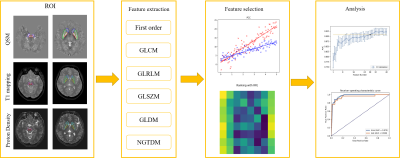Yi Duan1, Yida Wang1, Naying He2, Yan Li2, Zenghui Cheng2, Yu Liu2, Zhijia Jin2, Pei Huang3, Shengdi Chen3, Ewart Mark Haacke2,4, Fuhua Yan2, and Guang Yang1
1East China Normal University, Shanghai Key Laboratory of Magnetic Resonance, Shanghai, China, 2Department of Radiology, Ruijin Hospital, Shanghai Jiao Tong University School of Medicine, Shanghai, China, 3Department of Neurology, Ruijin Hospital, Shanghai Jiao Tong University School of Medicine, Shanghai, China, 4Department of Biomedical Engineering, Wayne State University, Detroit, MI, United States
1East China Normal University, Shanghai Key Laboratory of Magnetic Resonance, Shanghai, China, 2Department of Radiology, Ruijin Hospital, Shanghai Jiao Tong University School of Medicine, Shanghai, China, 3Department of Neurology, Ruijin Hospital, Shanghai Jiao Tong University School of Medicine, Shanghai, China, 4Department of Biomedical Engineering, Wayne State University, Detroit, MI, United States
We proposed a machine learning method to
distinguish Parkinson’s disease from normal controls based on five brain nuclei
visualized in STAGE imaging. The final radiomics model achieved an AUC of 0.948
in the testing dataset.

Figure 2. Flowchart for the radiomics experiments. The
last inset on the right contains the tuning feature number in the model with
5-fold cross-validation. A total of 28 features were kept in the final model
when the 1-SE rule was used (top). The ROC curves for the final model over
training and testing datasets (bottom).

